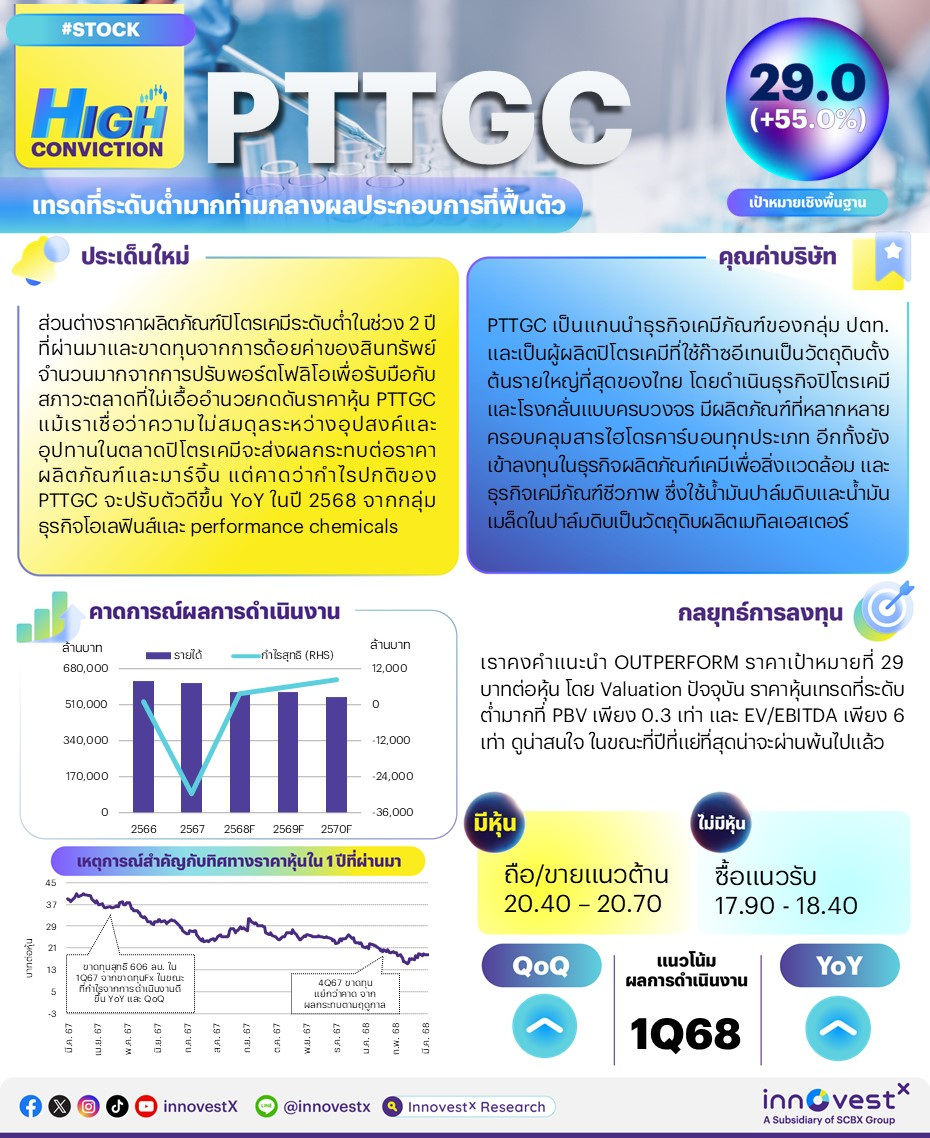High Conviction: PTTGC – เทรดที่ระดับต่ำมากท่ามกลางผลประกอบการที่ฟื้นตัว
ส่วนต่างราคาผลิตภัณฑ์ปิโตรเคมีระดับต่ำในช่วง 2 ปีที่ผ่านมาและขาดทุนจากการด้อยค่าของสินทรัพย์จำนวนมากจากการปรับพอร์ตโฟลิโอเพื่อรับมือกับสภาวะตลาดที่ไม่เอื้ออำนวยกดดันให้ราคาหุ้น PTTGC ปรับตัวลดลง 24% YTD เทียบกับ SET ที่ลดลง 15% แม้เราเชื่อว่าความไม่สมดุลระหว่างอุปสงค์และอุปทานในตลาดปิโตรเคมีจะส่งผลกระทบต่อราคาผลิตภัณฑ์และมาร์จิ้นอย่างต่อเนื่อง แต่เราคาดว่ากำไรปกติของ PTTGC จะปรับตัวดีขึ้น YoY ในปี 2568 โดยได้รับแรงหนุนจากกลุ่มธุรกิจโอเลฟินส์และ performance chemicals ราคาหุ้นปัจจุบันเทรดที่ระดับต่ำมากที่ PBV เพียง 0.3 เท่า และ EV/EBITDA เพียง 6 เท่า ในขณะที่ปีที่แย่ที่สุดน่าจะผ่านพ้นไปแล้ว เราคงคำแนะนำ OUTPERFORM สำหรับ PTTGC โดยให้ราคาเป้าหมายที่ 29 บาท/หุ้น อ้างอิง PBV ที่ 0.5 เท่า (-1.5SD)

ปัจจัยกระตุ้น #1: คาด sentiment ดีขึ้นด้วยแรงหนุนจากมาตรการกระตุ้นเศรษฐกิจของจีน เราคาดว่า sentiment ตลาดต่ออุตสาหกรรมปิโตรเคมีจะปรับตัวดีขึ้น โดยได้แรงหนุนจากมาตรการกระตุ้นเศรษฐกิจของจีนที่ทยอยออกมาอย่างต่อเนื่อง โดยเฉพาะมาตรการล่าสุดที่มุ่งกระตุ้นการบริโภคภายในประเทศ ซึ่งคาดว่าจะช่วยลดแรงกดดันจากการส่งออกของจีนไปยังเอเชียตะวันออกเฉียงใต้ซึ่งเป็นตลาดที่สำคัญของ PTTGC ทั้งนี้รายได้จากตลาดเอเชีย (ไม่รวมจีน) ของ PTTGC คิดเป็น 18% ของรายได้รวมในปี 2567 ขณะที่รายได้จากจีนคิดเป็นสัดส่วนราว 7%
ปัจจัยกระตุ้น #2: การดำเนินงานที่แข็งแกร่งขึ้นของ Allnex เราคาดว่ากำไรของกลุ่มธุรกิจ performance chemicals (22% ของ adjusted EBITDA ในปี 2567) จะปรับตัวดีขึ้นอย่างมากในปี 2568 หลังจากขายสินทรัพย์ที่สร้างผลขาดทุนของ Vencorex ออกไปเมื่อปีที่ผ่านมา ดังนั้นกำไรส่วนใหญ่ของกลุ่มธุรกิจนี้จะมาจาก Allnex ซึ่งจะได้รับแรงหนุนจากอุปสงค์ที่ดีขึ้นในยุโรปและเอเชียแปซิฟิก (โดยเฉพาะจีน) PTTGC คาดว่าปริมาณการขายของ Allnex จะเติบโตเป็นตัวเลขหลักเดียวระดับกลางในปี 2568 พร้อมกับการปรับปรุงประสิทธิภาพเพิ่มเติมมากกว่า 30 ล้านยูโร เป้าหมายระยะยาวสำหรับ EBITDA ของ Allnex ถูกตั้งไว้ที่ 600 ล้านยูโรภายในปี 2573 เทียบกับ 272 ล้านยูโรในปี 2567 โดย 78% ของงบลงทุนเพื่อการเติบโตทั้งหมดในปี 2568-2572 ของ PTTGC จะถูกจัดสรรให้กับการขยายธุรกิจของ Allnex
ปัจจัยกระตุ้น #3: คาดกำไรปกติปรับตัวดีขึ้นในปี 2568 เราคาดว่ากำไรปกติปี 2568 จะได้รับการสนับสนุนจาก EBITDA margin ที่ฟื้นตัวดีขึ้นของกลุ่มธุรกิจโอเลฟินส์จากการมีสัดส่วนวัตถุดิบอีเทนเพิ่มขึ้นเป็น 38% (เทียบกับ 33% ในปี 2567) และส่วนแบ่งขาดทุนที่ลดลงจาก JV ในธุรกิจผลิตภัณฑ์ขั้นกลาง (เทียบกับส่วนแบ่งขาดทุน >9.5 พันลบ. ในปี 2567) ซึ่งเป็นผลมาจากการตั้งรายการด้อยค่าและสำรองค่าใช้จ่ายที่เกี่ยวข้องจากการยุติการดำเนินกิจการของ PTTAC ทั้งนี้ PTTGC น่าจะสามารถรับรู้ผลประโยชน์ราว 4.6 พันลบ. จากการปรับพอร์ตโฟลิโอ ซึ่งส่วนใหญ่เกิดจากมาจากการยุติการดำเนินกิจการของ PTTAC และการขายกิจการ Vencorex นอกจากนี้การริเริ่มโครงการต่างๆ เพื่อปรับปรุงประสิทธิภาพ ลดต้นทุน และเพิ่มขีดความสามารถในการแข่งขันน่าจะทำให้ PTTGC สามารถผ่านพ้นสภาวะอุตสาหกรรมที่ยากลำบากในปี 2568 ไปได้
ปัจจัยกระตุ้น #4: รักษาความสามารถในการแข่งขันด้านต้นทุนไว้ได้ในระยะยาว PTTGC จะสามารถรักษาความสามารถในการแข่งขันด้านต้นทุนวัตถุดิบเอาไว้ได้ในระยะยาว เนื่องจากบริษัทได้ลงนามในสัญญาจัดหาอีเทนนำเข้าจากบริษัทแห่งหนึ่งในสหรัฐฯ (Enterprise) เป็นระยะเวลา 15 ปี โดยใช้เงินลงทุนเพิ่มเติมเพียง US$133 ล้าน (สอดคล้องกับกลยุทธ์ asset light) ซึ่งจะช่วยให้ PTTGC มีปริมาณวัตถุดิบอีเทน เพิ่มขึ้นถึง 400,000 ตันต่อปีตั้งแต่ปี 2572 เป็นต้นไป ผู้บริหารคาดว่าจะได้รับผลประโยชน์ US$40 ล้านต่อปี ซึ่งหมายถึงระยะเวลาคืนทุนไม่ถึง 4 ปี การจัดหาอีเทนเพิ่มเติมจะช่วยเติมเต็มช่องว่างระหว่างอุปทานภายในประเทศ 1.9 ล้านตันต่อปีจาก PTT กับกำลังการผลิตสูงสุดของ PTTGC ที่ 2.5 ล้านตันต่อปีได้บางส่วน
กลยุทธ์การลงทุนและคำแนะนำ เราเชื่อว่า PTTGC ผ่านจุดที่แย่ที่สุดในปี 2567 ไปแล้ว valuation ปัจจุบันสำหรับปี 2568 ที่ EV/EBITDA 5.9 เท่า และ PBV 0.3 เท่า ดูน่าสนใจเมื่อเทียบกับค่าเฉลี่ยของหุ้นกลุ่มเดียวกันในตลาดภูมิภาคที่ 8.9 เท่า และ 0.7 เท่า ตามลำดับ ราคาเป้าหมายของเราที่ 29 บาท อิงกับ PBV (ปี 2568) ที่ 0.5 เท่า (-1.5SD ของค่าเฉลี่ย 5 ปี) เพื่อสะท้อนความกังวลเกี่ยวกับอัตราภาษีนำเข้าใหม่ของสหรัฐฯ ซึ่งจะส่งผลกระทบต่อกระแสการค้าสินค้าโภคภัณฑ์ทั่วโลก ราคาเป้าหมายของเราคิดเป็น EV/EBITDA (ปี 2568) เพียง 6.9 เท่า เทียบกับค่าเฉลี่ย 5 ปีที่ 12.6 เท่า
ปัจจัยเสี่ยงที่สำคัญ: 1) ราคาน้ำมันดิบและส่วนต่างราคาผลิตภัณฑ์ที่ผันผวนของธุรกิจโรงกลั่นและธุรกิจปิโตรเคมี 2) ต้นทุนวัตถุดิบที่สูงขึ้น โดยมีสาเหตุมาจากวัตถุดิบก๊าซที่ลดลง 3) รายการด้อยค่าของสินทรัพย์ 4) การเปลี่ยนแปลงกฎหมายเกี่ยวกับการปล่อยก๊าซเรือนกระจกและพลาสติกแบบใช้ครั้งเดียวทิ้ง (<3% ของกำลังการผลิต) และ 5) การเปลี่ยนแปลงนโยบายรัฐบาลในการจัดสรรอุปทานก๊าซภายในประเทศให้แก่ธุรกิจปิโตรเคมี ปัจจัยเสี่ยงด้าน ESG ที่สำคัญ คือ ผลกระทบของธุรกิจต่อสิ่งแวดล้อม และการปรับตัวในช่วงเปลี่ยนผ่านสู่พลังงานสะอาดและเศรษฐกิจหมุนเวียน
Deep discount amidst earnings turnaround
The two years of poor product spread plus huge asset impairments as players adjust to the poor market climate has shoved PTTGC’s share price down 24% YTD vs. the SET’s drop of 15%. Although we believe the petrochemical demand-supply imbalance will continue to hurt product prices and margin, we expect PTTGC’s core profit to improve in 2025, driven by olefins and performance chemicals. Current share price is deeply discounted at only 0.3x PBV and 6x EV/EBITDA, but the worst is behind us. Maintain OUTPERFORM with 2025F TP of Bt29, on 0.5x PBV (-1.5SD).
Catalyst#1: Sentiment brightened by China’s stimulus. We expect market sentiment to improve, backed by a series of economic stimulus packages in China, especially the latest one, which aims at spurring domestic consumption. This should reduce pressure from China’s exports to SE Asia, PTTGC’s key market: revenue from Asian markets ex-China accounted for 18% in 2024, with revenue from China at just 7%.
Catalyst#2: Stronger operations at Allnex. We expect performance chemicals (22% of adjusted EBITDA in 2024) earnings to improve strongly in 2025 after divesting loss-making Vencorex last year. This means the majority of the profit from this segment will come from Allnex, backed by better demand in Europe and Asia Pacific (mainly China). PTTGC expects Allnex sales volume to grow in the mid single digits in 2025, adding €30mn. Long-term EBITDA target for Allnex is €600mn by 2030 from €272mn in 2024 with 78% of PTTGC’s total growth capex in 2025-2029 allocated to Allnex expansion.
Catalyst#3: Better core profit in 2025F. We expect 2025 core profit to be aided by EBITDA recovery at the olefins segment upon a higher proportion of ethane feedstock of 38% (vs. 33% in 2024) and lower losses from the JV in intermediate products (vs. a loss of >Bt9.5bn in 2024) from impairment and provisions for related expenses for withdrawal from PTTAC. PTTGC should be able to realize benefits of Bt4.6bn from the change in portfolio to dissolve PTTAC and divest Vencorex. Further, the initiatives to improve efficiency, reduce cost and increase competitiveness should enable PTTGC to sail through the rough industry outlook in 2025.
Catalyst 4: Secure long-term cost competitiveness. Feedstock cost competitiveness will be bolstered in the longer term by a 15-year supply agreement for imported ethane from a US company (Enterprise) with minimal additional investment of US$133mn (aligning with its asset-light strategy). This will increase PTTGC’s ethane feedstock by 400ktpa from 2029 onwards. Management expects benefit of US$40mn p.a., implying a <4-year payback period. The additional ethane supply will help fill the gap between domestic supply of 1.9mtpa from PTT and PTTGC’s maximum capability of 2.5mtpa.
Action & recommendation. We believe 2024 was PTTGC’s worst year. Current 2025F valuation of 5.9x EV/EBITDA and 0.3x PBV is compelling against regional average of 8.9x and 0.7x. Our TP of Bt29 is based on 2025F PBV of 0.5x (-1.5SD of 5-year average) to account for concerns about new US tariffs which may disrupt global commodity trade flow. Our TP is only 6.9x 2025F EV/EBITDA vs. 5-year average of 12.6x.
Key risk factors: 1) Volatile crude oil price and product spread for oil refining and petrochemicals, 2) higher feedstock cost due to lower gas feedstock, 3) asset impairment, 4) regulatory change on GHG emissions and single-use plastics (<3% of capacity), and 5) change in allocation of domestic gas supply to petrochemicals. Key ESG risk factors include the environmental impact of its business and how it adapts during the transition to clean energy and a circular economy.
Download EN version click >> PTTGC_HighConviction250325_E.pdf